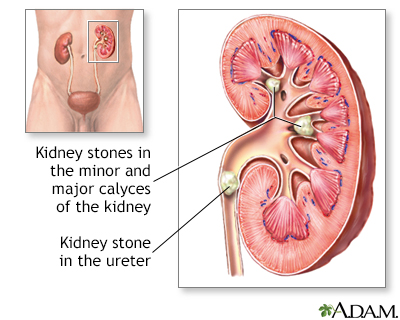Lithotripsy
Lithotripsy is a procedure that uses shock waves to break up stones in the kidney and parts of the ureter (tube that carries urine from your kidneys to your bladder). After the procedure, the tiny pieces of stones pass out of your body in your urine.
Description
Extracorporeal shock wave lithotripsy (ESWL) is the most common type of lithotripsy. "Extracorporeal" means outside the body.
To get ready for the procedure, you will put on a hospital gown and lie on an exam table on top of a soft, water-filled cushion. You will not get wet.
You will be given medicine for pain or to help you relax before the procedure starts. You will also be given antibiotics.
When you have the procedure, you may be given general anesthesia for the procedure. You will be asleep and pain-free.
High-energy shock waves, also called sound waves, guided by x-ray or ultrasound, will pass through your body until they hit the kidney stones. If you are awake, you may feel a tapping feeling when this starts. The waves break the stones into tiny pieces.
The lithotripsy procedure should take about 45 minutes to 1 hour.
A tube called a stent may be placed through your back or bladder into your kidney. This tube will drain urine from your kidney until all the small pieces of stone pass out of your body. This may be done before or after your lithotripsy treatment.
Why the Procedure Is Performed
Lithotripsy is used to remove kidney stones that are causing:
- Bleeding
- Damage to your kidney
- Pain
- Urinary tract infections
Not all kidney stones can be removed using lithotripsy. The stone may also be removed with:
- A tube (endoscope) inserted into the kidney through a small surgical cut in the back.
Tube
Percutaneous (through the skin) urinary procedures help drain urine from your kidney and get rid of kidney stones.
Read Article Now Book Mark Article - A small lighted tube (ureteroscope) inserted through the bladder into ureters. Ureters are the tubes that connect the kidneys to the bladder.
- Open surgery (rarely needed).
Risks
Lithotripsy is safe most of the time. Talk to your health care provider about possible complications such as:
- Bleeding around your kidney, which may require you to get a blood transfusion.
- Kidney infection.
- Pieces of the stone block urine flow from your kidney (this may cause severe pain or damage to your kidney). If this happens, you may need additional procedures.
- Pieces of stone are left in your body (you may need more treatments).
- Ulcers in your stomach or small intestine.
- Problems with kidney function after the procedure.
Before the Procedure
Always tell your provider:
- If you are or could be pregnant
- What medicines you are taking, even medicines, supplements, or herbs you bought without a prescription
During the days before the procedure:
- You will be asked to stop taking blood thinners such as aspirin, ibuprofen (Advil, Motrin), warfarin (Coumadin), and any other medicines that make it hard for your blood to clot. Ask your provider when to stop taking them.
- Ask your provider which medicines you should still take on the day of the procedure.
On the day of your procedure:
- You may not be allowed to drink or eat anything for several hours before the procedure.
- Take the medicines you have been told to take with a small sip of water.
- You will be told when to arrive at the hospital.
After the Procedure
After the procedure, you will stay in the recovery room for up to about 2 hours. Most people are able to go home the day of their procedure. You will be given a urine strainer to catch the bits of stone passed in your urine.
Go home the day of their procedure
A kidney stone is a small solid mass made up of tiny crystals. You had a medical procedure called lithotripsy to break up the kidney stones. This a...

Outlook (Prognosis)
How well you do depends on the number of stones you have, their size, and where in your urinary system they are. Most of the time, lithotripsy removes all the stones.
Reviewed By
Kelly L. Stratton, MD, FACS, Associate Professor, Department of Urology, University of Oklahoma Health Sciences Center, Oklahoma City, OK. Also reviewed by David C. Dugdale, MD, Medical Director, Brenda Conaway, Editorial Director, and the A.D.A.M. Editorial team.
Bushinsky DA. Nephrolithiasis. In: Goldman L, Cooney KA, eds. Goldman-Cecil Medicine. 27th ed. Philadelphia, PA: Elsevier; 2024:chap 111.
Matlaga BR, Krambeck AE. Surgical management of upper urinary tract calculi. In: Partin AW, Dmochowski RR, Kavoussi LR, Peters CA, eds. Campbell-Walsh-Wein Urology. 12th ed. Philadelphia, PA: Elsevier; 2021:chap 94.
Zumstein V, Betschart P, Abt D, Schmid HP, Panje CM, Putora PM. Surgical management of urolithiasis - a systematic analysis of available guidelines. BMC Urol. 2018;18(1):25. PMID: 29636048 pubmed.ncbi.nlm.nih.gov/29636048/.




 All rights reserved.
All rights reserved.